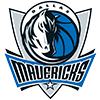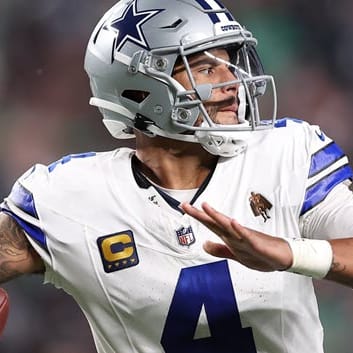This article will run through 10 ostensibly bold predictions about the 2024 NFL season. They're listed from most inflammatory to least, though that might be subjective.
Josh Allen will throw 20 interceptions
Subtracting Stefon Diggs and Gabe Davis to replace them with Curtis Samuel and Keon Coleman will make the Bills offense worse. It's not fair to expect Josh Allen to maintain the standard of production he set with the prior wideout crew when the new one will be worse. Even the relatively slight complication of Diggs' second-half struggles in 2023 was enough to scramble the formula that previously worked so well. If Diggs alone struggling can bring Allen's touchdown passing percentage down to 5.0 for the first time since 2019 and raise his interception percentage to 3.1 (the highest since Allen's rookie year), then imagine what removing Diggs entirely will do.
Samuel and Coleman should both be fine players, but neither is a true WR1. It's asking a lot for Samuel and Coleman combined to equal the effect of Diggs, and there's no depth to speak of behind those two and Khalil Shakir, who has a non-zero chance of finishing 2024 as the Bills' leading wideout. Shakir is a solid player capable of more than he's done to this point, but your offense is in a lot better shape when he's your WR3. In Allen's breakout 2020 season his WR1 was Diggs, his WR2 was Cole Beasley in the slot, and the WR3 was a rotation between John
This article will run through 10 ostensibly bold predictions about the 2024 NFL season. They're listed from most inflammatory to least, though that might be subjective.
Josh Allen will throw 20 interceptions
Subtracting Stefon Diggs and Gabe Davis to replace them with Curtis Samuel and Keon Coleman will make the Bills offense worse. It's not fair to expect Josh Allen to maintain the standard of production he set with the prior wideout crew when the new one will be worse. Even the relatively slight complication of Diggs' second-half struggles in 2023 was enough to scramble the formula that previously worked so well. If Diggs alone struggling can bring Allen's touchdown passing percentage down to 5.0 for the first time since 2019 and raise his interception percentage to 3.1 (the highest since Allen's rookie year), then imagine what removing Diggs entirely will do.
Samuel and Coleman should both be fine players, but neither is a true WR1. It's asking a lot for Samuel and Coleman combined to equal the effect of Diggs, and there's no depth to speak of behind those two and Khalil Shakir, who has a non-zero chance of finishing 2024 as the Bills' leading wideout. Shakir is a solid player capable of more than he's done to this point, but your offense is in a lot better shape when he's your WR3. In Allen's breakout 2020 season his WR1 was Diggs, his WR2 was Cole Beasley in the slot, and the WR3 was a rotation between John Brown and Gabe Davis. There's a formula that works for Allen and the Bills voluntarily removed it from the roster.
The starting loadout is unimpressive, the depth doesn't exist, and maybe worse than either point is the fact that the Bills lack a vertical element, especially if they use Samuel as a YAC-oriented slot wideout. Samuel is good in this capacity – he had an incredibly efficient season in the slot for offensive coordinator Joe Brady in Brady's first season with Carolina – but if Samuel is sitting underneath in the slot then the Bills will lack a vertical speed element. Shakir's 4.43 speed and solid skill set make him a somewhat capable downfield threat, but in this scenario the Bills might ask him to primarily play as a deep threat, which isn't his specific strength. An even worse nightmare scenario is the Bills appointing Coleman in the previous Gabe Davis role, where Davis' lack of speed made him a poor fit. Coleman is slower than Davis.
Brady is a good offensive coordinator and the Bills should be fine against weaker defenses, but the AFC East is challenging and Allen has less support than at any point since at least 2019, when his lead wideouts were Brown and Beasley. How confident are you that some combination of Samuel/Shakir/Coleman is definitely better than that? How confident are you that it's better enough to make Allen look less like 2019 and more like the four seasons since? I'm expecting something like 24 passing touchdowns and 20 interceptions for Allen.
Chris Rodriguez will bench Brian Robinson by mid November
Robinson shouldn't play ahead of Rodriguez at all, of course, but politics have their grip and it certainly would be foolish to assume Dan Quinn and Kliff Kingsbury would otherwise be ahead of any given curve. Robinson will begin the year as the lead Washington runner. The question is how long Washington stands around doing nothing to fix their offense as it otherwise struggles, reliably falling behind the chains when Robinson gets the ball. The struggles will initially be waved off as Growing Pains or some such thing since it's a new offensive scheme, but eventually Quinn and Kingsbury will feel the heat and need to make a change. They're not going to bench Jayden Daniels. They're not going to bench the receivers. So where does the change happen? You can see where it's going.
Whereas Robinson can't seem to produce as a runner despite being given endless opportunity against defenses that don't respect him, Rodriguez is the kind of runner who will catch your attention when you give him the ball. There's a reason why Rodriguez torched the same SEC that Robinson plodded through. Perhaps Robinson will have his customary workload set aside for him, but Washington will have to repeatedly witness the optics of their offense struggling with Robinson and improving whenever Rodriguez steps on the field. The one way Robinson might be better than Rodriguez is as a pass catcher, but Austin Ekeler is going to hold a monopoly on the pass-catching, anyway. If he's only a runner then it means that when Robinson goes on the field, the offense stops.
The numbers will eventually speak for themselves, but the optics are really a big part of this. Rodriguez isn't even that fast (4.52-second pro day 40), but when you watch the two players in succession it looks like Robinson is a changeup and Rodriguez is a triple-digit fastball... even though Rodriguez is only more like a 92mph fastball. The visual contrast is jarring even before you notice the discrepancy in their usage returns, but those too will speak with clarity soon enough. The calls for Rodriguez to start will begin in October and be heeded some time by November.
Jayden Daniels will finish with fewer fantasy points than Bo Nix
More specifically, let's say that Nix will average more fantasy points per start than Daniels. I'm not trying to lean on an injury technicality here, though that's certainly a concern with the reckless way Daniels runs. Other than Taylor Heinicke there is no quarterback in the NFL more liable to attempt Jackass stunts on the field.
Still, on a per-game basis I think Nix will be more productive. Not all of this is Daniels' fault – I wouldn't make this prediction if his playcaller were Ben Johnson, for instance – but the sad fact is that Daniels' offensive coordinator is Kliff Kingsbury. Kingsbury is a mess and it's tedious to talk about at this point. Daniels will not merely enter a poorly-coached offense, but rather he will enter one of the very worst-coached offenses. The Commanders are counting on third-round undersized tackle Brandon Coleman on the left side, and the Washington run game will be trash until they make the previously said benching of Brian Robinson for Chris Rodriguez. It's going to be rough.
I'm not saying it will go great for Nix in comparison – I'm definitely banking on Daniels struggling more than I'm predicting Nix to succeed – but Nix's fantasy upside is still understated. The Broncos will need to throw plenty, and Sean Payton still deserves some benefit of the doubt as an offensive coach. Nix is also probably more of a rushing threat than he gets credit for, especially when in the red zone.
George Pickens will score more 0.5PPR points than Malik Nabers
Nabers' ADP is out of control so there will be receivers other than Pickens who outscore Nabers this year despite going later in the order, but this blurb will focus on Pickens since there is an interesting and reasonable debate around his 2024 projection. The reason most prefer Nabers regardless of format is because they project many more targets for him than Pickens – so do I! – but the efficiency and touchdown production will be so heavily in Pickens' favor that he'll be one the to come out ahead in fantasy points.
The Pickens Pessimist is skeptical of his 2023 figure of 10.8 yards per target, convinced that it will drop in 2024. Just as in the question of the target count, I totally agree! Pickens' 10.8 yards per target figure is not sustainable, more specifically because his average yards after the catch from 2023 isn't sustainable. Pickens averaged 6.5 yards after the catch last year after averaging only 2.3 yards after the catch the year before. If you calculated Pickens' 2023 usage with the 2022 YAC figure instead it would cost him 265 yards, lowering his YPT from 10.8 to 8.3 and his yardage total from 1,140 yards to 875 yards. Lucky for us Pickens Optimists, the overall formula is more complicated than that.
Pickens drew 106 targets on 889 snaps at an ADOT of 13.4 yards in 2023. ADOT is a downward pressure on per-snap target rate, and Pickens' ADOT has been extremely high through two years. As much as we need to pay attention to per-snap target rates, any analysis that reduces Pickens to his raw target count fails to quantify the actual value of those targets. You see this mode of analysis often now, where Pickens drawing 106 targets at 13.4 yards is valuated the exact same as a player with 106 targets at a 7.5-yard ADOT. This is a huge mistake, because Pickens would have drawn far more than 106 targets if his ADOT were at that lower depth.
Good news! Pickens' ADOT will drop in 2024, and maybe by a lot. Pickens is an unmatched jumpball target and has Jedi-like abilities around the sideline, but that's not to say he can only play downfield and on the sideline. That's more or less how the Steelers used him the last two years, but that was out of necessity because while Pickens can make plays underneath, Diontae Johnson can only make plays underneath. So the division of labor practically arranges such that Johnson does what he can, and Pickens does what Johnson cannot. This arrangement no longer exists!
After drawing 21.9 percent of Pittsburgh's targets at 13.4 ADOT, the departure of Johnson compels Pittsburgh to give Pickens something more like 27 percent of their targets at an ADOT closer to 11.5. The lower ADOT will not only result in more targets per snap, but also more catches per target – Pickens' catch rate should jump from 59.4 percent last year to something closer to 64.0 percent or higher this year.
None of this is to account for the mammoth difference between Russell Wilson and Kenny Pickett/Mitch Trubisky/Mason Rudolph as passers. Wilson is a below average starting quarterback, sure, but at least he's top 50. You couldn't say that about any of the three from last year. The difference between Wilson and those goofballs might have been enough alone to offset Pickens' YAC regression. Not just that, but did you see the Denver offense last year? Did you see Courtland Sutton last year? Did you see the very particular way Wilson works – a sideline and corner shot specialist? Did you happen to notice that those parts of the field are the strengths of Pickens' game?
Can Pickens be among the league leaders in receptions or receiving yardage? No, the Steelers won't throw enough for that. But particularly given that the Steelers 'replaced' Johnson with practice squad fodder like Van Jefferson and a speed decoy like Roman Wilson the Steelers are absolutely compelled to feed Pickens this year. Like Sutton in 2023, Pickens will also claim an oversized share of whatever touchdown production occurs in the Pittsburgh passing game.
The problem for Nabers isn't talent – he's a monster and should be better than Pickens at some point – but even if Nabers were better now it still wouldn't be enough alone to catch Pickens' fantasy point total. The Giants attempted 489 targeted passes in 2022 – you know, the "good" Daniel Jones season. If we round up to 490 and give Nabers one third of the targets (an improbably huge target rate) you'd get roughly 160 targets.
Knowing that the defense is sitting on Nabers, and knowing the NYG ground game is no longer respected with Saquon Barkley gone, what level of efficiency do you expect from Nabers given who his quarterbacks are? Jones threw 15 touchdowns in 16 games and averaged 6.8 yards per pass in 2022 – again, the "good" season. If Nabers were to catch 65.0 percent of 160 targets at 7.5 yards per target it would yield 104 catches for 1,200 yards. This is the best-case scenario, and one unlikely to occur. Ja'Marr Chase drew 23.7 percent of Cincinnati's targets his rookie year. Do you like Nabers to clear that by nearly 10 points? Chase was clearly the better prospect.
In any case, even if Nabers is looking at 100 catches for 1,200 yards and maybe eight touchdowns, it still wouldn't be worth as many fantasy points in 0.5PPR (~220 points, 12.9 FPPG) as what Pickens will do this year. Think 85 receptions for 1,200 and 12 touchdowns (~230 points, 13.5 FPPG).
Chuba Hubbard will score more FPPG than Jonathon Brooks
The thinking is fairly reductive on this one. I think Brooks is a bit overrated in general – the NFL.com draft player profile comparing Brooks to Jamaal Charles is truly hilarious – but even if Brooks were clearly worth a second-round pick the circumstances still work against him at the moment.
It would be unwise in general to rush a player like Brooks back from a Nov. 11 ACL tear, but it would be especially negligent for a team like the Panthers to do it. The Panthers won't be competing for wins this year, and throwing Brooks into the fire is risky behavior for no payoff. Brooks got hurt in each of his three seasons at Texas. David Tepper is as incompetent as anyone, but would he really want Brooks to go four years in a row with notable injuries, especially when the most recent one was a mid-season ACL tear?
The other thing to keep in mind is that Chuba Hubbard is on the last year of his rookie contract. The Panthers can use a productive season from Hubbard to not only shield Brooks in a pointless 2024 season, but also to turn Hubbard into a compensatory fourth-round draft pick after he signs elsewhere in free agency.
Even aside from these speculative points, the more immediate reality is that there's no actual reason to believe Brooks is a better pure runner than Hubbard. Brooks definitely has Hubbard beat as a receiver, but the Panthers will need a run-heavy offense this year to shield the vulnerable Bryce Young. Hubbard ran for 2,094 yards (6.4 YPC) and 21 touchdowns in one year at Oklahoma State. Brooks ran for 1,479 yards (6.2 YPC) and 16 touchdowns in three years at Texas, mostly against backups and Kansas.
Josh Jacobs will be a top-five fantasy RB
It's odd to me that it's now an unchallenged assumption that Matt LaFleur Always Rotates His Running Backs, even though the sample from which this assumption was extracted only refers to years where LaFleur was handling Aaron Jones. It seems to me that the correct takeaway would be that Matt LaFleur Rotates Aaron Jones, and even that didn't apply in the final month of 2023. So it would seem more accurate yet that the takeaway should be Matt LaFleur Rotates Aaron Jones When LaFleur Thinks He Has A Similarly Effective Alternative.
As it turned out, when LaFleur didn't have a similarly productive alternative in 2023 he ran Jones into the ground, giving Jones 102 carries in the final five weeks. So if Matt LaFleur Always Rotates His Running Backs then just what the hell happened in December and January last season?
The answer is that LaFleur doesn't do X, Y or Z for the sake of doing it, or because he has a rule that he must do it. LaFleur more so just seems pragmatic, and his decision to rotate Jones when possible was more so just LaFleur reaching the conclusion that Jones can't withstand such workloads physically, and therefore Jones' usage would best be limited so as to preserve his availability. Josh Jacobs has of course been injured plenty over the years, but he also played very well through many or most of those injuries, and he incurred those injuries while operating as a workhorse. Jones was liable to get hurt well before the point of reaching a workhorse threshold, even while avoiding the teeth of the defense with toss, sweep and screen-type plays. Jacobs can take a halfback dive and make it sting for the defense.
Green Bay's decision to move on from a beloved player like Jones and replace him with a more expensive Jacobs indicates a fairly clear intent. Namely, you delete a player like Jones and replace him with a player like Jacobs because Jacobs allows you to do something that you wanted to do with Jones but could not. Not only can Jacobs withstand more work than Jones in general, but Jacobs specifically thrives with power running that didn't suit Jones. The Packers at one point theorized that Jones and AJ Dillon would give their backfield the necessary assortment of explosiveness and power to win a Super Bowl, but in this offseason they appeared to conclude that Jacobs alone presents whatever it was they hoped Jones and Dillon to combine to be.
Anyone pointing to MarShawn Lloyd as a concern might as well point at Dillon or Emanuel Wilson instead. The Packers didn't select Lloyd in the late third round because they needed him, but rather because they had an excess of early draft picks on a roster with few needs. Lloyd's biceps are literally too massive to form an effective High and Tight grip on the football, putting a bull's eye on him like no runner in recent or distant history. Lloyd fumbled 11 times on just 325 touches from scrimmage in college! Lloyd certainly has some tools to work with (4.46-second 40 at 5-foot-9, 220 pounds), but it looks like five of those pounds are just bad mass in parts of his arms that don't contribute to grip strength and instead just limit his reach. Lloyd is a project, and one with about as many fumbles and injuries as quality reps to this point.
The Packers offense is clearly going places, and Jacobs will be on the field for that offense around 40 snaps per game, and more in high-leverage cases. Jacobs will rarely leave the field because his presence on the field tips off nothing to the defense. Whatever the play call, he can do it well. Jacobs not rotating is part of why it's going to be so difficult to predict Green Bay's play calls before the snap. If he gets hurt he gets hurt, but if Jacobs stays healthy he's going to rake this year. At the very least I can't imagine how a person could conclude Jacobs is at more risk of rotation or injury than Kyren Williams, a 5-foot-9, 195-pound back with two high ankle sprains, one broken foot and one other unspecified foot injury before reaching the 265-carry mark in his career.
C.J. Stroud will lead the NFL in passing touchdowns
No advanced thought to this one. Just looking at the basic details, the trends are setting up for a mammoth season from Stroud. We know Stroud is generally capable of leading the league in passing touchdowns – it wouldn't be surprising if he did it multiple times in his NFL career – so why not start now?
Indeed, the timing couldn't be much better because Stroud has an absolutely loaded group of pass catchers. This offensive personnel can shoot it out with anyone. It's not just that Stroud will be throwing to Nico Collins, Stefon Diggs and Tank Dell, though. The additional two interesting details here is that the Texans defense should be very good, setting up Stroud with consistently favorable field position, yet the Texans running game probably will convert that field position to touchdowns at an average at best rate. Joe Mixon can withstand volume and should see plenty of it, but he's a plodding runner and one who will watch Stroud "steal" a bunch of red-zone touchdowns.
Stroud would still have a good shot at leading the league in passing touchdowns if the Texans defense were worse and if they had a killer running back like Jonathan Taylor rather than an average one like Mixon. But the fact is that this extremely capable, well-armed passer will have a lot of time on his hands in scoring range, and he'll take whatever meat Mixon leaves on the bone.
Marquise Brown will score at least 10 touchdowns
Brown is not a true WR1 in the NFL. He's not strong enough at the catch point to deal with the contact that comes with a lead-target role, to the point that it rattled his entire rhythm with the Ravens and Cardinals. None of this will matter in the Chiefs offense.
The correct way to use a player like Brown is in a moderate-usage, high-explosiveness role. When you target a player like Brown more selectively you make it harder for the defense to know when the next strike will occur. It's easy to control Brown when the defense sells out to stop him every play, but when the defense drops its guard that's when you set Brown loose for the kill shot. With Travis Kelce as the functional WR1, defenses will commit far less attention to Brown in Kansas City than they did in Arizona or Baltimore.
The Brown you'll see in Kansas City will look a lot more like the Brown you might remember from Oklahoma. In Brown's career-best season with Baltimore he caught 91 receptions at 11.1 yards per catch. Expect his 2024 figures to look more like 70 or 75 catches at 15.5 yards per catch or more. In a Patrick Mahomes offense that would pretty easily make Brown a steal at his current ADP, which is largely a tossup between him and Xavier Worthy. Worthy should not be so close to Brown in the ADP, by the way.
Justin Herbert will throw for 4,300 yards and 30 touchdowns
Greg Roman might have called a lot of rushing plays when his quarterbacks were Lamar Jackson, Tyrod Taylor and Colin Kaepernick, but Justin Herbert is a fundamentally different quarterback. If you try to make Herbert run like those three the offense won't go, so the Chargers won't call the offense like they would with those other three quarterbacks.
It's certainly true that Herbert will throw fewer passes than he would have under the prior regime, and the 5,000-yard passing offense is long gone as a result. That still doesn't make it reasonable for Herbert to fall behind the likes of Jayden Daniels or especially Jared Goff. Based on the cumulative ADP of Herbert and his wide receivers you'd almost think the Chargers were switching to a wishbone offense. No team is going to try to hide Herbert as a passer, not even one with Greg Roman at offensive coordinator.
Bad as it was for Herbert to lose Mike Williams and especially Keenan Allen, the Chargers still have good on-hand personnel between Ladd McConkey, Joshua Palmer and DJ Chark. Certainly not world-beating, but good enough to threaten all parts of the field and provide Herbert with quality target options through all phases of the game. McConkey and Palmer should rotate effectively between flanker and the slot, while Chark will be Herbert's best deep target since Tyron Johnson.
DJ Moore will be a top-10 fantasy WR in all scoring formats
This isn't very bold, but oh well. I expect Moore's ADP to rise in the upcoming weeks/months, but in the meantime he tends to go in the third round of drafts and later than players like Marvin Harrison, Brandon Aiyuk, Davante Adams and Mike Evans. That's too late.
Tyson Bagent threw 27.9 percent of Chicago's passes last year and the comparatively effective Justin Fields still only completed 61.4 percent of his passes at 6.9 yards per attempt. Perhaps it's true that Moore's 70.6 percent catch rate is due for some regression and with that his share of the team receptions and receiving yardage might decline after producing an absurd 39.9 percent of Chicago's receiving yardage in 2023, but with Caleb Williams at quarterback the pie is about to get considerably bigger, and probably more rapidly than any regression in Moore's numbers.
The Bears threw for 3,421 yards and 19 touchdowns last year. Williams should lead them to something close to or more than 4,000 yards and well over 20 touchdowns through the air, conservatively. The additions of Keenan Allen and Rome Odunze are not serious concerns, because if Moore 'only' claims 25.0 percent of the team targets (28.5 percent in 2023) then it still projects for something like 30.0 percent or more of the team's overall passing yardage. Moore should match last year's yardage total while potentially scoring more touchdowns, even if his reception count declines slightly.




































